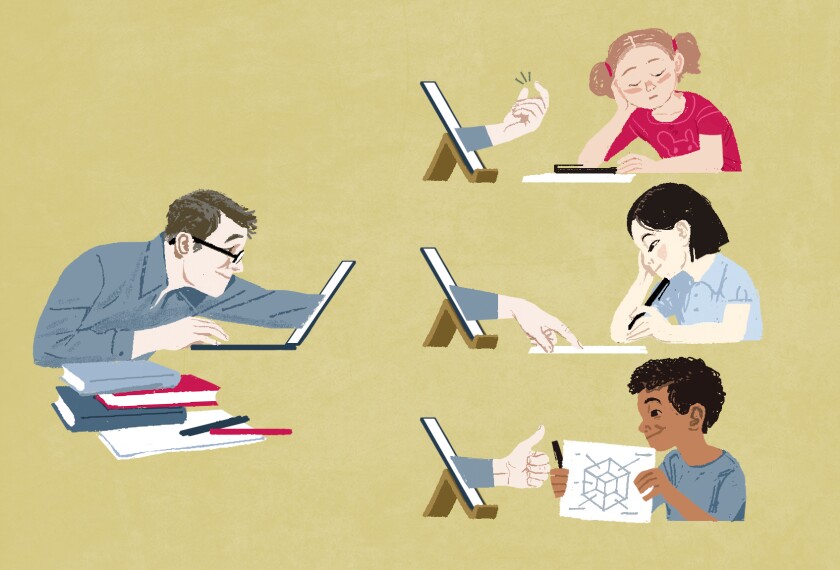School districts all over the country spent the 2020-21 school year using a mix of in-person and remote instruction to keep kids learning while limiting the spread of COVID-19. At the beginning of this school year, however, their focus has shifted almost entirely from such hybrid learning models to a mix of fully in-person learning and full-time virtual schools.
That switch in philosophy, detailed in a recent Education Week special report, left some experts concerned about continuity of learning in the face of rising virus-related quarantines.
“I see the fact that schools aren’t making plans for continued disruptions as irresponsible,” said Michael K. Barbour, an expert in virtual learning at Touro University California, as the new academic year got underway. “The reality is that this school year is going to look a lot more like 2020-21 than 2018-19.”
The charts below detail the dramatic drop in hybrid learning in K-12 schools. All figures are from a nationally representative survey of 1,241 ���Ķ���vlog administered online by the EdWeek Research Center in late August and early September.
1. The use of hybrid learning has declined dramatically.
Last year, more than two-thirds of ���Ķ���vlog said their district used a hybrid model that mixed in-person and remote instruction. In 2021-22, that figure is down to less than one-fourth.
“The goal this year was to really stand up in-person learning for students five days a week. Going into the summer, that seemed feasible,” said Raymond C. Hart, the executive director of the Council for Great City Schools, a 75-member coalition including many of the country’s largest urban school systems.
With the Delta variant raging and a small but significant subset of schools forced to enact new quarantines, leaving thousands of students without clear paths to connect to their classrooms, that approach has caused some second-guessing. But Hart said districts were following both the science and the state and federal guidance that was available over the summer.
“Districts first and foremost were trying to ensure they could implement mask mandates and mitigate the spread of the virus,” he said. “They could try to address the challenges of quarantine after that.”
2. Full-time virtual schools are now the go-to “hybrid” option.
Complicating matters, the time and resources schools have invested in remote learning has been largely focused on standing up full-time virtual schools.
Barbour of Touro University California described that strategy as a smart response to the pressures of a competitive school-choice marketplace, especially in states with a robust cyber-charter sector. At the same time, however, full-time virtual schools likely won’t help with emergency COVID-19 outbreaks, in large part because students are often required to be enrolled for an entire semester or academic year.
“For districts to move some of their eggs into that basket is a good strategy,” he said. “But they’re not going to be able to handle [quarantined students] at scale.”
3. The overwhelming majority of teachers are back on campus, teaching solely in-person students.
Just 7 percent of teachers told the EdWeek Research Center they’d be teaching a mix of in-person and remote learners this school year.
In places like Hillsborough County, Fla., that represents a dramatic shift from last year, when the 220,000-student school system rolled out a robust hybrid “eLearning” model that had teachers instructing in-person and remote students simultaneously. Teachers were exhausted by that approach, said Stephanie Baxter-Jenkins, the executive director of the local teachers’ union. But the decision to scrap hybrid learning has created new problems this school year, when as many as 11,000 students have been quarantined at a time.
Hybrid instruction “was completely overwhelming, doubled our work, and burnt teachers out,” Baxter-Jenkins said. But this year, “I think people are struggling with how to handle the amount of quarantined kids we have.”
4. Remote students have been left to learn via a grab-bag of instructional models.
Attending full-time virtual schools? Working with dedicated online teachers? Following along with in-person lessons as they’re livestreamed on a video conferencing platform? Working independently on “asynchronous” classwork?
For better or worse, remote students are doing it all this year.
Such variety and flexibility could be an encouraging sign that schools are moving away from one-size-fits-all models of education, said Susan Patrick, the president and CEO of the Aurora Institute, an advocacy group that promotes personalized learning.
But making these new approaches actually work will take planning and long-term investment.
“The barriers for states are finding the will to change, and modernizing and retooling teacher-training and professional development programs,” Patrick said. “The pandemic may be here longer than anyone initially anticipated, and schools leaders need to find a path forward.”








